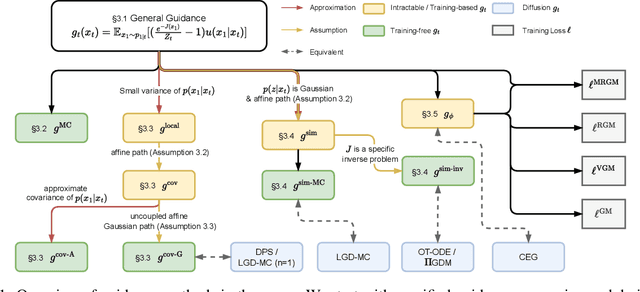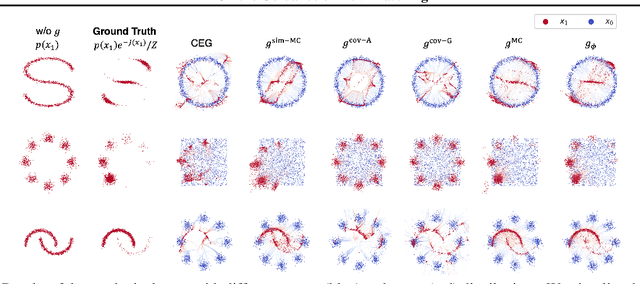Wenhao Deng
On the Guidance of Flow Matching
Feb 04, 2025



Abstract:Flow matching has shown state-of-the-art performance in various generative tasks, ranging from image generation to decision-making, where guided generation is pivotal. However, the guidance of flow matching is more general than and thus substantially different from that of its predecessor, diffusion models. Therefore, the challenge in guidance for general flow matching remains largely underexplored. In this paper, we propose the first framework of general guidance for flow matching. From this framework, we derive a family of guidance techniques that can be applied to general flow matching. These include a new training-free asymptotically exact guidance, novel training losses for training-based guidance, and two classes of approximate guidance that cover classical gradient guidance methods as special cases. We theoretically investigate these different methods to give a practical guideline for choosing suitable methods in different scenarios. Experiments on synthetic datasets, image inverse problems, and offline reinforcement learning demonstrate the effectiveness of our proposed guidance methods and verify the correctness of our flow matching guidance framework. Code to reproduce the experiments can be found at https://github.com/AI4Science-WestlakeU/flow_guidance.
From Uncertain to Safe: Conformal Fine-Tuning of Diffusion Models for Safe PDE Control
Feb 04, 2025



Abstract:The application of deep learning for partial differential equation (PDE)-constrained control is gaining increasing attention. However, existing methods rarely consider safety requirements crucial in real-world applications. To address this limitation, we propose Safe Diffusion Models for PDE Control (SafeDiffCon), which introduce the uncertainty quantile as model uncertainty quantification to achieve optimal control under safety constraints through both post-training and inference phases. Firstly, our approach post-trains a pre-trained diffusion model to generate control sequences that better satisfy safety constraints while achieving improved control objectives via a reweighted diffusion loss, which incorporates the uncertainty quantile estimated using conformal prediction. Secondly, during inference, the diffusion model dynamically adjusts both its generation process and parameters through iterative guidance and fine-tuning, conditioned on control targets while simultaneously integrating the estimated uncertainty quantile. We evaluate SafeDiffCon on three control tasks: 1D Burgers' equation, 2D incompressible fluid, and controlled nuclear fusion problem. Results demonstrate that SafeDiffCon is the only method that satisfies all safety constraints, whereas other classical and deep learning baselines fail. Furthermore, while adhering to safety constraints, SafeDiffCon achieves the best control performance.
Exploring the Upper Limits of Text-Based Collaborative Filtering Using Large Language Models: Discoveries and Insights
May 19, 2023Abstract:Text-based collaborative filtering (TCF) has become the mainstream approach for text and news recommendation, utilizing text encoders, also known as language models (LMs), to represent items. However, existing TCF models primarily focus on using small or medium-sized LMs. It remains uncertain what impact replacing the item encoder with one of the largest and most powerful LMs, such as the 175-billion parameter GPT-3 model, would have on recommendation performance. Can we expect unprecedented results? To this end, we conduct an extensive series of experiments aimed at exploring the performance limits of the TCF paradigm. Specifically, we increase the size of item encoders from one hundred million to one hundred billion to reveal the scaling limits of the TCF paradigm. We then examine whether these extremely large LMs could enable a universal item representation for the recommendation task. Furthermore, we compare the performance of the TCF paradigm utilizing the most powerful LMs to the currently dominant ID embedding-based paradigm and investigate the transferability of this TCF paradigm. Finally, we compare TCF with the recently popularized prompt-based recommendation using ChatGPT. Our research findings have not only yielded positive results but also uncovered some surprising and previously unknown negative outcomes, which can inspire deeper reflection and innovative thinking regarding text-based recommender systems. Codes and datasets will be released for further research.
 Add to Chrome
Add to Chrome Add to Firefox
Add to Firefox Add to Edge
Add to Edge